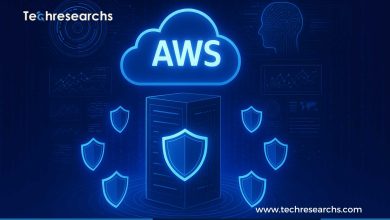The AWS Security Model: Why Some Pen Testing Fails

When teams move to the cloud, they often assume their usual security practices will follow them — including penetration testing. But AWS Security works differently. It’s based on a shared responsibility model that changes the game for how you manage and test your environment.
If you’ve ever run a pen test on AWS and found… well, not much — you’re not alone. Many tests fail to uncover actual vulnerabilities, not because they aren’t there, but because the AWS security model demands a new approach.
In this article, we’ll break down why traditional pen testing sometimes fails in AWS, what you should know about the model itself, and how to test more effectively in the cloud.
Understanding the AWS Shared Responsibility Model
At the heart of AWS Security is a model that divides security responsibilities between Amazon Web Services and you, the customer.
Here’s how it works:
- AWS is responsible for the security “of” the cloud – the infrastructure that runs all AWS services.
- You are responsible for security “in” the cloud – including the data, applications, and settings you control.
In other words: AWS keeps the hardware safe. You need to secure your software and configurations.
Why Traditional Pen Testing Fails in AWS
Penetration testing is designed to simulate real-world attacks. But in AWS, some tests fall flat. Here’s why:
1. Testing the Wrong Layer
Most pen testers target infrastructure — trying to exploit server vulnerabilities, open ports, or operating system weaknesses. But in AWS:
- You don’t manage the infrastructure.
- That means your test isn’t even hitting your responsibility zone.
Focus needs to shift to what you do control — misconfigured S3 buckets, exposed IAM policies, or overly permissive APIs.
2. Permission and Legal Constraints
AWS requires approval for certain types of testing. Simulating DDoS attacks or scanning AWS infrastructure can violate your agreement — and even get your account suspended.
3. Not Accounting for Cloud-Native Risks
Cloud environments introduce new risk factors:
- Over-permissioned IAM roles
- Public storage buckets
- Poor logging and monitoring setups
These aren’t your classic server vulnerabilities. They’re misconfigurations, often invisible to traditional tools.
Key Areas to Focus on AWS Pen Testing
So, where should your security team look instead?
1. IAM (Identity and Access Management) Configurations
Check for:
- Admin-level roles attached to multiple services
- Users with excessive privileges
- Access keys that never expire
2. S3 Bucket Permissions
Are your storage buckets public when they shouldn’t be? Are you using encryption?
3. API Gateway and Lambda Functions
APIs are often exposed to the public internet. Look for:
- Weak or missing authentication
- Improper input validation
- Insecure data handling
4. Logging and Monitoring
If you’re not logging CloudTrail, you’re flying blind. Without proper visibility, threats go unnoticed.
5. Misconfigured Security Groups
These act like firewalls. Open ports or loose inbound rules can lead to serious issues.
Summary Table: Why Some AWS Pen Tests Fail
| Reason | Explanation |
|---|---|
| Testing AWS infrastructure | AWS owns and secures the underlying infrastructure |
| Ignoring cloud-native risks | S3, IAM, and API misconfigs often go unnoticed |
| Violating AWS test policies | Some types of testing are restricted or require prior approval |
| Outdated security mindset | Traditional testing doesn’t adapt to cloud-first architecture |
How to Improve Your AWS Security Testing Strategy
Follow these tips to align better with the AWS model:
Map Responsibilities First
Before testing, clarify what you’re responsible for: configurations, policies, and data. Build your test strategy around those.
Use Cloud-Native Tools
- AWS Config: Monitors compliance
- GuardDuty: Detects threats using machine learning
- Security Hub: Centralizes security findings
Simulate Insider Threats
Since the biggest threats in AWS are often internal misconfigurations, simulate an internal attacker misusing IAM roles or exfiltrating data.
Integrate DevSecOps Early
Shift security left. Integrate pen testing into CI/CD pipelines and use automated tools to catch risks before they hit production.
FAQs on AWS Security and Pen Testing
1. Is penetration testing allowed on AWS?
A. Yes, but only certain types of tests are allowed without prior approval. These include testing EC2 instances, RDS, Lambda, and more — within policy.
2. Why don’t traditional tools work well in AWS?
A. Because you don’t have access to the infrastructure layer. Traditional scanners may overlook IAM misconfigurations, public S3 buckets, or exposed APIs.
3. What tools are recommended for AWS-specific security?
A. Use AWS-native tools like Config, Guard Duty, and Trusted Advisor. Also, cloud-specific platforms like Prisma Cloud and Wiz are gaining popularity.
4. Can I run vulnerability scans on my EC2 instances?
A Yes, as long as you own and operate them. But it’s still important to stay within AWS’s testing boundaries.
Shifting the Security Mindset for AWS
AWS Security isn’t about finding the same old holes in a different environment. It’s about understanding what you control — and securing it. When pen testing fails, it’s often a sign of an outdated security strategy, not a secure environment. Modern cloud security is more about configuration hygiene, identity management, and visibility than brute-force scanning. If your team is still testing AWS like it’s a traditional data centre, now’s the time to change that. Understanding the AWS model isn’t just smart — it’s essential for keeping your cloud environment secure.



